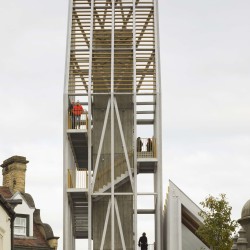Auckland Tower among the Nominees for 2022 European Union Prize for Contemporary Architecture – Mies van der Rohe Award.
The historic home of the Prince Bishops of Durham, Auckland Castle is one of the most important and best-preserved bishops’ palaces in Europe. In 2012 it was taken over by regional charity, The Auckland Project, and has been transformed into a faith, art and heritage destination of international significance. Auckland Tower in Bishop Auckland acts as an access point and gateway to The Auckland Project, a new visitor destination in the North East of England. The building provides ticketing, information, and orientation for the refurbished Castle and new Faith Gallery. The tower offers views over the town and landscape beyond.
The site provides a spatial connection between the castle complex and the town’s Market Place. The timber building is conceived as a long hall, reminiscent of a market hall. The hall is raised above ground level, open to views of the Market Place and Castle setting. It is used for exhibitions and events. The building’s other function is as the first port of call for visitors to the Castle and its various museums and galleries. It houses a shop, ticket office and toilet facilities.
The form and construction of the tower is intended to echo lightweight provisional structures that would once have clustered around castle walls. It allows people to look into the castle and understand the previously secluded world. It would make the castle accessible to the town and its people.
The walls of the Welcome Building are engraved in-text telling the story of the castle through history. First-floor timber shutters pivot open when the castle opens, giving the structure an open, kinetic quality. The ceiling of the hall carries stencilled representations. Our intention is that the building is not simply a container for interpretation but participates in the representation of the site through its own features.
The timber frame structure is made from European Larch glulam. The softwood is protected in grey surface treatment to help the weathering process. This treatment will eventually weather off to reveal the silver-grey, naturally weathered wood beneath. The grey exterior of the building appears in contrast to the luminous golden colour of the interior.
_















